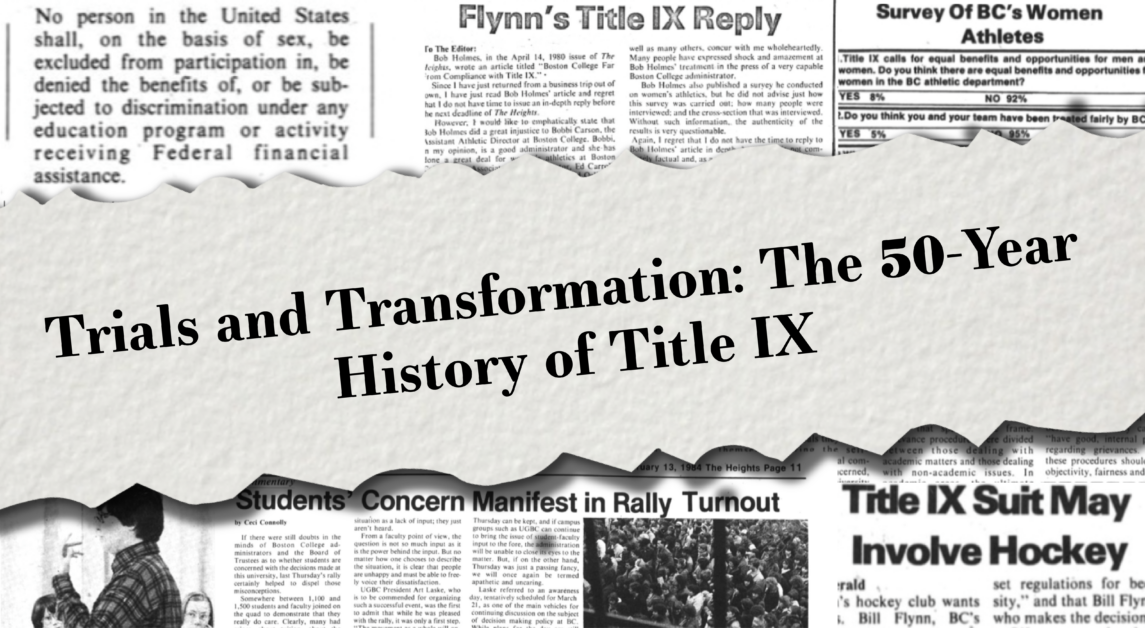The beginning of the 1970s marked a period of tumult.
The U.S. had invaded Cambodia during the Vietnam War. In response, students across the nation began to strike in May 1970.
Such unrest was not foreign to Boston College’s campus. In April 1970, BC students went on strike against the recent raise in tuition. The marching band blared their instruments throughout academic buildings to disrupt classes, students vandalized offices, and many members of the Class of 1970 graduated BC without completing their classes.
Later that decade, the passage of one law would sustain this turmoil for years to come.
Title IX—passed on June 23, 1972—prohibits discrimination based on sex within educational programs or activities that receive federal funding in a mere 37 words:
“No person in the United States shall, on the basis of sex, be excluded from participation in, be denied the benefits of, or be subjected to discrimination under any education program or activity receiving Federal financial assistance.”
Kathie Skinner, BC ’70, said Title IX, which initially sought to enforce equality between men’s and women’s sports in schools, was an extension of the progressive culture of the 1960s.
“I think that, in terms of women becoming integral into the University in general, [it started] in the late ’60s, which kind of was what the late ’60s were all about … breaking the norms of the past and kind of moving into the future,” she said. “So I think in that regard, Title IX is an extension of that.”
Skinner said when Congress passed Title IX, she was most affected by the push toward more opportunities for women in intercollegiate sports.
“When I was at BC … I don’t think that there were that many opportunities for women who wanted to play sports to do so,” Skinner said. “And so … that’s what I remember most about Title IX, expanding those opportunities and really forcing schools to, I think, kind of treat women equally as much as possible.”
A primary point of controversy after the passage of the law was how equal funding for both male and female sports would affect male sports. At the time, the National Collegiate Athletic Association said it would negatively impact male sports.
The law’s brevity allowed leeway for educational administrators and students across the nation to interpret it differently. In order to create consistency, the U.S. Department of Health, Education, and Welfare (HEW) drafted its regulations of Title IX’s implementation in April 1974. These regulations prohibited discrimination based on sex regarding the choice of sports and their competitive levels, scholarships, and coaching and instruction. Another regulation required schools to have a male and a female team, a co-ed team, or no team at all for any given sport.
Responding to this draft, the National Association for Collegiate Athletic Directors sent a letter to former President Richard Nixon, requesting that he examine such regulations. The association claimed this implementation of Title IX would be disruptive and counterproductive.
Bill Flynn, BC’s athletic director from 1957 to 1990, responded to the draft saying BC was doing all it could to make men’s and women’s athletics equal. He said he believed the regulations were unrealistic and that BC offered equal sporting equipment and coaching based on need and student interest.
He questioned whether women athletes would want to partake in equal scheduling and competitive level as men.
HEW’s Title IX regulations went into effect on July 21, 1975, three years after Congress passed the law. One year later in 1976, then-Director of the Office of Affirmative Action Alice Jeghelian said BC had passed its self-evaluation of its compliance with the regulations.
Though Flynn had questioned female athletes’ interest in competing at the same level as male athletes, in 1979 and 1980, the women’s club soccer team and the women’s club hockey team, respectively, asked Flynn for varsity status—these requests were denied. The women’s club soccer team then filed a Title IX violation.
When Amy Campbell, the first woman to receive an athletic scholarship for basketball at BC, arrived on the Heights in 1977, she said she expected BC would have provided more support and resources for its female athletes.
“They gave you a uniform with the words ‘Boston College’ on it, and, you know, that was pretty much what they gave us,” Campbell, BC ’81, said. “There wasn’t a lot of other support.”
The team had only one part-time coach and no assistant coaches when Campbell arrived. The women’s locker room was small and had two showers, but only one could be used at a time due to water pressure problems, according to Campbell, and the players could not access the locker room until their coach was there.
Campbell and her teammates had to wash their own uniforms, had no practice uniforms, and had to walk from the Roberts Center to the Plex for athletic training before or after practice, unlike the male athletes who had training in the Roberts Center. They could only use the gym during dining hall hours, making it difficult to eat food other than the late night offerings. They traveled to games in a van driven by their coach or trainer, and they rarely had a bus or a meal allowance while traveling.
During her junior year, Campbell said she and her other co-captain of the team, Kristin Fullam, BC ’81 , met with Flynn to express the team’s needs and complaints. This was an eye-opening experience for Campbell, she said, as the meeting made it clear to her that nobody had been advocating for the team.
“I feel like he was genuinely surprised at our requests, and, you know, to me, that was really telling because it was like, ‘Well, if he’s surprised by what our needs are, then our needs are not being represented, you know, to him or to the administration,’” Campbell said.
Her second coach during her time at BC, coach Carol Swindler, filed a Title IX complaint with HEW and later left BC in 1980, Campbell said. An investigation ensued following the complaint.
The resources provided to female players began to improve as a result of this complaint, Campbell said—players got practice uniforms and laundry pins, an improved locker room, access to training facilities at the Roberts Center, and a full-time coach.
“Getting a full-time coach was huge,” Campbell said. “You can’t build a program without having somebody in charge.”
Although Campbell said there was still much more progress to be made—the team needed assistant coaches and travel budgets—these improvements were a strong step in the right direction.
After graduating, Skinner worked at BC where she said she witnessed the demographic changes that took place on campus as a result of Title IX.
“I worked at BC for about five years after I graduated, so … what I noticed was there were more women on campus,” Skinner said. “Because when … one out of every six [students] is female and all of a sudden, that percentage grows, you start to notice it, walking across the Dustbowl and things like that.”
To combat the continued differences in interpretation, HEW proposed a policy for determining an institution’s compliance with Title IX in 1978—examining expenditures and plans to expand opportunities for women. Then, in 1979, the Office of Civil Rights (OCR) issued the official compliance guidelines, including an institution’s athletic benefits, athletic opportunities, and accommodation of student interest.

Despite improvements in implementing the law, more than 95 percent of BC female athletes thought their team was not being treated fairly at BC, according to a survey conducted by former Heights editor Bob Holmes.
Flynn responded to this survey in a Letter to the Editor calling the validity of the survey into question.
One inequality that persisted into the 1980s was disproportionate scholarship allocation. In the beginning of the 1980s, the U.S. government found an inadequate ratio between men’s and women’s scholarships and ordered BC to increase the ratio to three women’s scholarships for every five men’s scholarships from 1980 to 1983, according to Kip Gregory, BC ’83, in a Letter to the Editor.
In 1984, Grove City College v. Bell changed the scope and implementation of Title IX once again. The Supreme Court ruled that educational institutions only need to guarantee women equal rights in programs which directly receive federal funding, narrowing the scope of Title IX and weakening its impact.
Jeghelian expressed concerns that the change would cause a slow reversal to the prior inequality. Then-women’s field hockey coach Karen Keough, however, said she did not think the change would affect BC, as Title IX had already made a positive impact on the University and its athletics.
Toward the end of the 1990s, BC, failing to meet Title IX standards, announced it had created a five-year plan to ensure equal athletic opportunities. Subsequently, men’s lacrosse, water polo, and wrestling were designated as club sports, but this change would not happen immediately. Instead, there would be a four-year transition period to respect the athletes on those teams at the time of the announcement.
“We thought this was the right thing to do,” Athletic Director Gene DeFilippo said in a 1998 Heights article. “In most of these situations, an institution will make the change from varsity to club sport status immediately, but we felt it important to honor the commitment we made to the students recruited for the teams, and this four-year transition period will enable us to do that.”
Despite these considerations, many athletes were upset with this decision. In a Letter to the Editor published in The Heights, Chris Celentano, a member of the wrestling team and BC ’00, said that he was disheartened by the news and concerned that BC was disregarding smaller sports.
“BC has been under intense pressure to achieve gender equity and comply with Title IX,” Celentano said. “The Athletic Department has chosen the easiest way to comply with this vague statute: cutting men’s sports. … In reality, [this] creates no new opportunities for women and takes away opportunities from men.”
Another part of this five-year plan was the addition of a women’s rowing team and 44 new scholarships for female athletes, nine of which would be taken from the football, ice hockey, and basketball programs combined.
Tom O’Malley, head women’s ice hockey coach in 1999, said the team was often competing with other colleges and universities with more scholarships to give out before it received increased resources from the five-year plan. With more scholarships, he said, the team began to compete better and improved quickly.
Meanwhile, gender equity at BC was not only being discussed in relation to athletics but in relation to academics as well, as Mary Daly, a theology professor who joined the BC faculty in 1966, received national media attention for her policy of excluding male students from her classes.

For years, many male students tried to join her classes and failed, but when Duane Naquin was unable to join Daly’s class in September 1998, he reported a complaint to the University. After the Center for Individual Rights threatened to sue BC on Naquin’s behalf, the University supported his rights under Title IX and later reported that Daly agreed to give up tenure and retire, as she would not teach in a mixed-gender classroom. Daly, however, never signed the papers and sought a preliminary injunction against BC in 1999. Middlesex Superior Court Justice Martha Sosman ruled in favor of BC that May.
“Indeed, there is no question that the school has adequate cause to terminate Daly if, for some reason, her promise to resign turns out to be unenforceable,” Sosman said in a 1999 Heights article. “Boston College has made clear its policy that students are not to be excluded from or dissuaded from taking classes on account of their gender, and Daly has made equally clear that she will not abide by that policy.”
To further develop how Title IX compliance would be examined at educational institutions, in 2002, the U.S. Secretary of Education created the 15-person Commission on Opportunity in Athletics—which included DeFilippo—to assess Title IX, in part due to the rising criticism that the law decreased opportunities for male student athletes in non-revenue sports.
Just six years earlier, only 32 percent of BC’s athletes were female, but in 2003, that number had risen to 49 percent.
While DeFilippo said Title IX played a part in downgrading men’s water polo, lacrosse, and wrestling, it was only one of the factors.
“We found that there was overburdening on the weight room, the training room, and the equipment rooms,” DeFilippo said in a 2003 Heights article. “We also looked at facilities; we aren’t able to have a lot of playing fields because we’re so landlocked at BC. We asked ourselves if a sport was a fit at BC. Was a sport one that’s sponsored by the Big East conference? Gender equity was only part of the decision process.”
DeFilippo said the recommendations that would be a result of the commission’s report would not have much effect on BC, as BC was already in line with Title IX.
“Boston College has already made a major commitment to be in compliance with Title IX, not just because it is the law, but rather because we felt it was the right thing and the fair thing to do,” DeFilippo said in a 2003 interview.
He also pointed to the amount of scholarships BC had as evidence of BC’s compliance.
“We have approximately 375 men and approximately 375 women participating in our athletic program,” he said. “We have approximately 125 scholarships for men and approximately 125 for women. We have added 45 scholarships on the women’s side; 36 of those were new scholarships and nine of those we took from men’s sports and moved them over to the women’s side.”
In order to comply with Title IX, schools must pass one of the following three requirements: the percentage of male and female athletes is substantially proportionate to the percent of male and females enrolled at the school, the school has a history and continuing practice of expanding participation opportunites for the underrepresented sex, or the school is fully and effectively accomodating the interests and abilities of the underrepresented sex.
Under the third requirement, schools do not have to accommodate the athletic interests of the “underrepresented sex” unless there is proof a school has not established a sport despite sufficient interest shown by the students.
In 2005, the Department of Education offered clarification to this requirement, saying that institutions can periodically use email surveys to gauge student interest in a sport. This decision gained criticism, with many saying emails should not be a legitimate way to measure interest as many students do not always answer their email.
BC, however, said this clarification would not affect the University, as it does not rely on email surveys for this purpose.
Five years later, in April 2010, the Department of Education reversed its decision to allow email as a valid form of gauging student interest.
In February 2010, a Heights report showed BC’s athletic department spent $1.14 million more on male athletic scholarships than female athletic scholarships in the 2008–2009 academic year, despite there being more female than male athletes. BC gave $7.63 million in scholarships to male athletes, while it gave $6.49 million to female athletes.
Under Title IX, universities that provide athletically related financial aid must afford “substantially proportionate funding”—defined as exactly proportionate or within a one percent disparity—to male and female athletes.

BC attributed this disparity to a number of different things.
“We budget the scholarships 50 / 50,” said Eric Ziady, associate athletics director of business operations at the time. “Every year there’s going to be some variance in terms of how much is actually awarded just based on what recruits accept scholarships.”
DeFilippo also attributed the disparity to the number of male athletes that attend summer classes at BC.
“More men go to summer school,” DeFilippo said. “Men’s football and men’s basketball stay both summer sessions, and our other programs just stay one session. They’re required to go to school in the morning, and in the afternoon they work out on their own. It allows you to go a course lighter during the year or to make up for a course that you may have had to drop.”
According to the NCAA guide at the time, examples of legitimate factors when accounting for inequalities in scholarship spending include actions taken to promote the development of athletic programs, unexpected variations in male and female participation rates, and unexpected last-minute decisions by recruits not to enroll.
Title IX’s scope further expanded when former Vice President Joe Biden announced an initiative inviting high school and college students to submit ideas on how their school could better prevent sexual assault on their campuses on Sept. 13, 2011 in honor of the 17th anniversary of the Violence Against Women Act (VAWA).
Biden’s initiative came after an April 2011 Dear Colleague Letter, which encouraged a new interpretation of Title IX—one focusing on sexual harassment—and clarified the law’s formerly vague language.
In response to this initiative, BC formed a Title IX Steering Committee to evaluate the University’s compliance with Title IX and how they could further improve their policy.
“The main focus thus far has been … to identify requirements, researching how Boston College currently addresses those requirements, and making recommendations for changes in policy and protocol to ensure not only compliance, but the highest level of safety for the well-being of the Boston College community,” said Patrick Rombalski, then-vice president of student affairs, in a 2011 Heights article.
Elizabeth Rhodes, a professor of Hispanic studies and a member of the committee, said at the time, BC already took sexual assaults seriously, even before the committee was formed.
“Whether justice happens or not is a completely different question,” Rhodes said in the 2011 Heights article on BC’s sexual assault response protocol. “But BC does not brush [sexual assaults] off.”
One of the major issues at BC, however, was the lack of knowledge among both students and faculty as to how to properly respond if someone confided in them about sexual assault and what resources were available for victims, Rhodes said in the 2011 article.
About a year later, in November of 2012, BC announced the expansion of sexual assault resources at the University, including a new webpage which would, in one location, list all the resources available, with the goal to increase and facilitate awareness.
Further solidifying the University’s sexual harassment protocol, BC revised its misconduct policies in the summer of 2014, establishing precise definitions for key terms and creating an investigative model for examining confidential cases. BC’s Women’s Center also hired Rachel DiBella in 2014, who worked specifically on sexual assault response services.
That same year, according to a 2015 Heights article, BC was not included on a list of colleges and universities that violated Title IX released by the Department of Education in May 2014. Although, nearby universities, such as Boston University and Harvard University, were on that list.
Despite its recorded compliance, another investigation of BC’s accordance with Title IX ensued against the University in December 2015. An alumnus claimed he had been wrongfully accused of committing sexual assault in 2012, which sentenced him to a three-semester suspension. DNA evidence was released the February after his suspension, however, and it did not reveal him as the perpetrator. The investigation went through the OCR—the first time BC had been involved in an OCR investigation regarding sexual assault, Katie O’Dair, then-associate vice president for student affairs said in a 2016 Heights interview.
As BC improved its sexual assault recording process and resources, the number of reported cases began to climb. From 2013 to 2014, BC’s reported sexual assault cases jumped from 11 to 23. A report released in the fall of 2016 showed this upward trend continued, as BC’s reported cases went from 23 to 27 from 2014 to 2015, according to a 2017 Heights article. Katie Dalton, then-director of the Women’s Center, said that this increase is an increase in reporting, rather than an increase in cases. She attributed this rise to the improved outreach and education of prevention and response at BC.
As BC expanded its resources and specified its policies, the U.S. government also specified its federal policies regarding sexual assault on college campuses—limitting the reporting of cases.
Betsy DeVos, former U.S. secretary of education under former President Donald Trump’s administration, aimed to narrow colleges’ accountability for sexual assault cases. In 2018, she released her proposal to only hold schools accountable for cases formally filed through appointed officials and for cases that occurred on their campuses. This change in Title IX’s trajectory marked another shift in interpretation of the law, straying from the former President Barack Obama’s administration’s broader definition of sexual assault.
In January of 2019, then-Boston Mayor Martin Walsh, BC ’09, publicly denounced this shift in Title IX. He claimed it would discourage students from reporting cases and disapproved of the change that universities would not be responsible for off-campus cases. That same month, the Association of Independent Colleges & Universities in Massachusetts followed suit, issuing a public comment denouncing Title IX’s change under the Trump administration.
More recently, after several Trump-administration policies restricted transgender rights, the Department of Education, under the Biden administration, announced on June 16, 2021 that transgender individuals were now recognized under the protections of Title IX, according to an article from The New York Times.
The inclusion of transgender individuals under Title IX is part of a larger effort from the Biden administration to reverse the policies implemented against transgender individuals during Trump’s presidency.
According to The Washington Post, when the Department of Education finalizes this policy, it will come at odds with 12 states’ laws barring transgender women from competing in women’s sports, such as Texas and Florida.
Though Title IX has sparked various points of debate during its 50-year history, J. Joseph Moakley Professor of Political Science Kay Schlozman said the general aim of Title IX is not controversial and that the law was successful in its goals of reaching gender equality.
“Title IX itself, especially as it affects non-athletic parts of institutions of higher education, is not particularly controversial,” Schlozman said. “Yes, there was a certain amount of back and forth about the sexual assault and sexual harassment stuff. But it’s not the thing that most divides the parties from one another, and there’s a grand canyon between them on many, many issues. That said, [it] is a very important piece of legislation and has made a huge difference for [women.]”
As a student before the passage of Title IX, a BC employee just after its passage, and currently an occasional visitor of campus, Skinner experienced all of the changes and progressions BC underwent. Skinner said Title IX was a significant contributor to increasing the number of women on BC’s campus and improving their treatment.
After attending BC when women were expected to always wear skirts and were not allowed to sit on grass on campus, Skinner said she has seen the drastic progression of gender equality at BC, which she largely attributes to Title IX.
“I still go to the campus because I go to games, and my kids went to BC, so I see just an enormous change in complexity and complexion of the University since I was there as a student in a very positive way,” she said.
MC Claverie contributed to reporting.



















